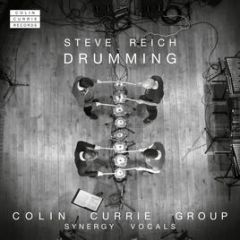Steve Reich - Drumming (2018)
Steve Reich - Drumming (2018)

1. Drumming: Part I [16:28] 2. Drumming: Part II [17:22] 3. Drumming: Part III [11:47] 4. Drumming: Part IV [09:30] Colin Currie Group
Steve Reich's Drumming is regarded as one of the most important musical works of the last century. Distilled through his studies of African percussion in Ghana during 1970 and Balinese gamelan music, Reich revolutionized our understanding of polyrhythms, sculpting a new sonic territory to illuminate the radical potential of Minimalism.
Divided into four sections, performed without pause, Drumming is written for eight small tuned drums, three marimbas, three glockenspiels, piccolo and voice. The singers recite melodic patterns that mimic the sounds of the instruments, gradually rising to the surface and then fading out. The overall effect can be transfixing – pulling listeners into the rhythm and possessing a raw immediacy, directness and energy.
The premier performances of Drumming took place in December 1971 in New York City – first at The Museum of Modern Art, then at Brooklyn Academy of Music and finally at Town Hall where this recording was made – and featured the composer along with a cast of longtime collaborators including Art Murphy, Steve Chambers, Russ Hartenberger, James Preiss, Jon Gibson, Joan La Barbara, Judy Sherman, Jay Clayton, Ben Harms, Gary Burke, Frank Maefsky and James Ogden.
Originally released in 1972 by gallerist John Gibson in a small private edition, Drumming represents the culmination of Reich's investigation into rhythmic phase relationships and its early realization captures a remarkably organic feel, especially compared to the more widely known version on Deutsche Grammophon from 1974. ---superiorviaduct.com
Eight bongos, three marimbas, two women’s voices (one doubling as a whistler), three glockenspiels and a piccolo; that’s the line-up for Steve Reich’s masterpiece Drumming. In live performance it is all amplified, though not for the reason you might first expect. Certainly it makes it louder and helps the music punch through; however the real reason for amplification is to balance the wildly different timbres of the instruments and voices and to help bring forward their character and colour.
Steve’s music is a treat to mix live. It is at once still, yet driven forward by kaleidoscopic changes in timbre and teasing melodic and rhythmic ambiguities. Indeed, some of the melodies and rhythms we hear are not even notated in the score. They result from the collision of repeated patterns; but more interestingly, they also arise from the fusion of the harmonics of those sounds. It’s an aural illusion, a subtle alchemy in sound and it’s why I love this piece.
In recording Drumming for this album, Colin wanted to preserve the thrilling sound of live performance and combine it with the precision of a studio session. We began by laying out the studio exactly as we would a stage, with marimbas on the left, glocks on the right, singers and piccolo at the back and bongos front and centre; you’ll hear this in the recording. We chose not to vary the layout with each movement; by wheeling marimbas into the centre of the image for Part 2 for example. Then we miked it as we would for a live show – close up. A second array of microphones, this time with a bit more distance between the instruments and the microphones, gave us a sense of space and depth. The recording you’ll hear is a mix of all these perspectives. It gave us the possibility of focusing in on musical lines when they’d be otherwise lost in the overall sound; it’s something I have to do all the time when I’m mixing a live show.
Each performance of Drumming is unique and differs in subtle ways from any other, particularly during the phasing of patterns. To put this another way, whilst the destination points for the phasing of patterns remain the same, the journeys to them are always different. This makes editing tricky and so we made a point of recording in long takes, allowing patterns to evolve naturally and with fluency.
We recorded the work in one single - exhilarating - day in May 2017. ---Ian Dearden, gramophone.co.uk
download (mp3 @320 kbs):








